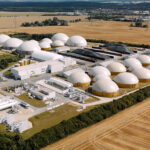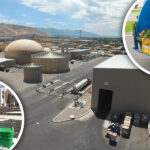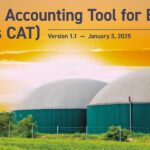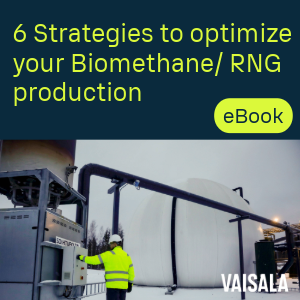Small-scale digester at an experimental station in Costa Rica has potential to be a model for rural communities throughout Latin America.
Katrina Mendrey
BioCycle March/April 2014
Michigan State University (MSU) researchers are taking advantage of the reliable solar energy of the tropics to heat an anaerobic digester that not only produces biogas, but is the first step in a process that reclaims water and nutrients. The project is the result of a partnership between researchers in the departments of Biosystems and Agricultural Engineering at MSU and Agricultural Engineering at the University of Costa Rica (UCR). Other institutional partners include Universidad Nacional Autónoma de Nicaragua León and Universidad Autónoma de Chiriquí in Panama.

The solar-biopower unit includes a 32 m2 solar thermal panel, a 20 m3 digester and a 50 m3 biogas storage bag (close up of digester and storage bag on left). One metric ton/day of poultry and cattle manure and food waste is processed.
The continuously stirred tank reactor (CSTR) is housed at the Fabio Baudrit Experimental Station located near Alejuela, Costa Rica, where other projects include a poultry breeding program and a plant genetics laboratory mostly focusing on mangos and papaya. The location was chosen as the project fits in well with other work at the experimental station, which is focused on sustainable agriculture and science. Finding a site in Latin America was important to the project as the region is characterized by unequal distribution of income with a majority of the poor living in rural areas. Bringing reliable sources of renewable energy to these regions would help alleviate some of the issues associated with rural poverty.
“Anaerobic digesters aren’t new in this region,” says Dana Kirk, manager of Anaerobic Digestion Research at MSU. “But the technologies that exist are mostly low-tech, low-cost bag systems not designed for optimization or longevity.” The CSTR system can mske full use of resources and potential to extract energy, water and nutrients from local waste streams more efficiently.
The system is designed to operate at thermophilic temperatures (45-55°C or 113-131°F) as opposed to mesophilic (35-40°C or 95-104°F), temperatures that would be sustained in most areas of the United States. Prior to designing the digester, a bench top experiment was performed in both Costa Rica and Michigan to compare microbial communities in digesters at the different temperature regimes and in the different locations. The experiment also tested different feedstock mixtures for optimization. Wei Liao, project co-principal investigator and Associate Professor at MSU, reports that results from this experiment indicated that geography had little influence on biogas productivity. Rather, culture temperature, hydraulic retention time and composition of feedstocks were the primary factors influencing gas production. Results from the study indicated that an 80:20 mixture of poultry manure to food waste resulted in a 37 percent increase in biogas production when digested at 50°C compared to 35°C in 20 days of the hydraulic retention time. Other ratios of manure to food waste tested included 100:0 and 90:10.
System Design
The system in place in Costa Rica has a total footprint of 900 m2 (about 10,000 sq. ft). Water is used as the heating transfer fluid to maintain the reactor temperature. Thermophilic temperatures are sustained using a solar thermal collector to heat the water to 70°C during daylight hours. The heated water is stored in a tank to sustain temperatures of 45°C in the reactor over a 24-hour period allowing the digester to operate continuously. The cool water after heating the reactor is circulated back to the solar thermal collector, and reheated to 70°C.
With a capacity of 20 cubic meters (5,300 gallons), the CSTR is fed one metric ton (1.1 tons) of material per day consisting of approximately 70 percent poultry manure, 20 percent cattle manure and 10 percent food waste. The final mix has a C:N ratio of 15:1. The feedstocks come mostly from the experimental station’s poultry and farming operations, as well as preconsumer kitchen scraps collected from UCR cafeterias and local restaurants. The food scraps and cattle manure are collected in 50-gallon plastic drums that are delivered weekly to the site. The poultry manure is collected on site using recycled feed sacks. It also contains some wood shavings used as bedding.
The feedstocks are ground on-site using a hammer mill and auger typically used by the coffee industry. The mixture is diluted to about 4 percent solids with reclaimed water. Feedstocks are stored at ambient temperatures for 24 to 48 hours before being fed into the digester. Hydraulic retention time in the digester is approximately 20 days.
The biogas produced is about 60 to 65 percent methane. The biogas is stored in a 60 cubic meter gas bladder. Daily gas production is around 8 to 12 cubic meters, and is used to run two 16 kW combined heat and power (CHP) units. This electricity is used to power plastic grinding at a recycling facility located near the site. In the next phase of the project the energy might also be used to power an adsorption chiller to provide cooling for produce grown at the site.
Water And Nutrient Recovery
After treatment the digestate passes through a solids separator, which removes particles over 1mm (<half-inch) from the liquid stream. Until recently, any chunks or pieces were collected for composting with plant waste produced at the station. However, a recent salmonella outbreak attributed to the cattle manure has led to temporarily discontinuing composting. (Undigested manure residue in the transfer barrels contaminated the digested solids.) For now, the remaining solids are mixed with soil in a nearby field.
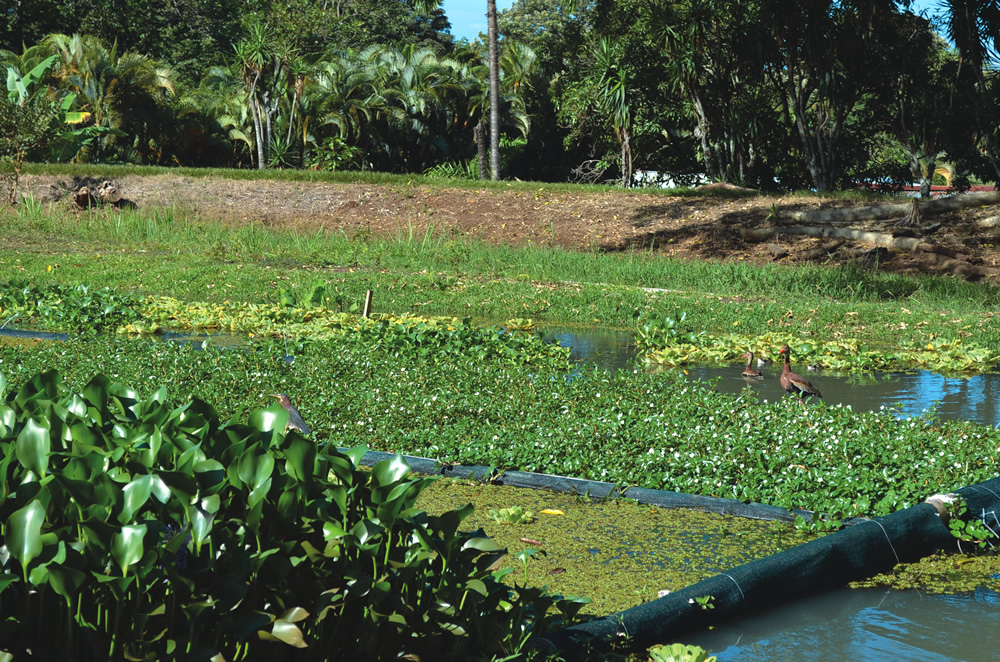
Effluent (filtrate) from the digester is treated in a wetland with some vegetation and two open surface filters with floating plants and vegetative mats.
The filtrate (liquid portion) is passed through a series of sand and wetland filters two of each. The filtration system includes an initial sand filter followed by a planted wetland with some vegetation and two open surface filters with floating plants and vegetative mats. Vegetation includes papyrus (Cyperus papyrus), iris (Iris gaminea), juncus (Juncus effusus), bandera (Canna indica), Job’s Tears (Coix Laycrma jobi L.), water lettuce (Pistia stratiotes) and water hyacinth (Eichhornia crassipes). According to Ronald Esteban Aguilar Alvarez, Graduate Research Assistant in MSU’s Department of Biosystems and Agricultural Engineering, the plants were chosen for their known abilities to withstand wet soil conditions and their local availability either from nurseries or collected from Costa Rican forests. The sand and wetland cells also are used for other effluent treatment research.
Data collection from the wetland is currently underway. To date, qualitative sampling has demonstrated measurable differences in water clarity as water moves through the filtration cells. Additionally, researchers are monitoring the wetland to identify optimal plant species, harvest times and processes as well as how to handle harvested plants.
Water collected from the last cell is being used to dilute feedstocks into a pumpable slurry prior to digestion and to reduce the nutrient concentration in liquid digestate to a level tolerated by the wetland plants. Eventually, the recovered water could be used as irrigation for crops or to offset potable water consumption elsewhere. “This is really looking at combining both organic waste management, renewable energy and water quality needs of a developing region and doing it in an optimized way,” explains Kirk.“It is more sophisticated than the traditional systems.”
Cost And Payback
Kirk is the first to admit that with this sophistication comes a cost. The entire project including design, construction, monitoring and outreach has been funded with a $1 million grant from the U.S. Department of State’s Division of Western Hemisphere Affairs. The prototype system currently in operation at the experiment station cost $150,000 USD including instruments and control units (this is included in the $1 million total). The current payback period is seven to ten years and is based mostly on capital offsets provided by savings from the energy generated. Electricity in Costa Rica is relatively clean and inexpensive. Most of the energy is produced by hydro and is around $0.17/kWh. Kirk believes a more desirable payback period of less than six years could be possible. “If we could extract value from the digestate or have a system that is marketing salable compost or if we had situations where there was a liability on the feedstocks then the savings would help reduce the payback period,” says Kirk.
For now, Kirk is confident that the payback period will be shortened as the system is perfected with the partnership between MSU engineers and local implementers, including those in the coffee industry. “There is enough technical expertise both in Michigan and Costa Rica that the next system will be simpler, more robust and more cost-effective than the system we have today.”
Experiences drawn from this initial project, Kirk believes, will certainly help reduce costs even in the next project. For example, many of the challenges presented by the first project have been worked out through simple communication, especially given the language barriers. For example, the CAD drawings for the engineered system were contracted out to a local firm that drafted the plans in Spanish making implementation easier for local contractors. In addition, the team in Costa Rica was able to identify local manufacturers to provide much of the equipment including the auger, grinder, conveyor belts, solids separator and hot water storage tanks — all items used by the coffee industry. “It was a good partnership for the coffee industry and potentially something that could hopefully allow them to diversify their manufacturing base,” explains Kirk.
While the initial project started in 2011, the system has now been running smoothly for several months and the team hopes to expand the project through outreach to other Latin American communities. Currently a portable digester consisting of a 500 L (132 gallons) reactor tank, 150 L (40 gallons) water tank and a two by one meter (6.5-ft by 3.2-ft) solar panel is being used to test this type of system at a dairy farm and will later be used at a coffee farm. Researchers hope this will lead to further implementation of the technology across Latin America. Other similar projects under various stages of development that are supported by MSU are under way in Africa and Southeast Asia.


